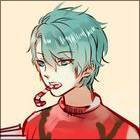THE DO'S AND DON'TS OF MAPPING PART 4
The Specific Basics: Towns
 Archeia_Nessiah
Archeia_Nessiah- 07/12/2011 03:56 AM
- 7285 views
Even when the Engine is Rm2003 it can still be applied to every level design related.
Table of contents:
1 The basics
a the 'yeses'
b the 'noes'
2 The specific Basics:
a Mountains
b Forests
c Towns (you are here)
d Deserts
e Plains
f World Map Tips
3 Adding to a map
a Eventing
b Overlapping
c Effects
d Overlays
*****************************************************************************
Towns are one of the most important parts in a game solely because of the huge amount of time you spend in them. If you’re game is something like mine, were you get to a town and stay in that central area for hours doing quests, it’s important to have a good looking town that has many things to do in it. There are three types of towns in my opinion. They are:
Castles
Open Plains
In closed areas (such as towns in a cave, on a mountain, etc.)
Castles: Castle towns are important to many games, but an important thing is to have residences. All castles have rooms for there knights to live in, but for some reason people tend to forget about that. However, I’m talking more about the exterior of a town, not the insides. Castle towns should have houses on the outside, in a courtyard fashion. Example:
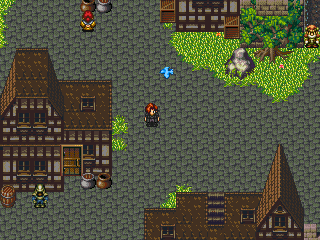
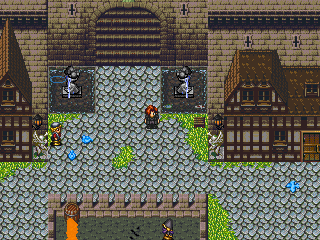
As you can see, the place still has an outdoor castle feel, but it’s also got all the things a town would have, such as houses and people and bird and… on and on. You also don’t need a lot of space between places like you do in other maps, and as I go into property, you’ll figure out your own ways of doing that yourself (canvas tents, welcome mats, etc.)
Open Plains: These are by far the most common of all, and appear at least 5 times in most games. That is why it’s important to make them stand out. Space is the most important thing in any town, and it’s especially important here. You need a lot of space between each house, but you don’t want it to look like there’s a lot of unclaimed land. That’s what thing I call “property markers” are for. These markers aren’t houses, but they show property and ownership of a house still the same. Examples:
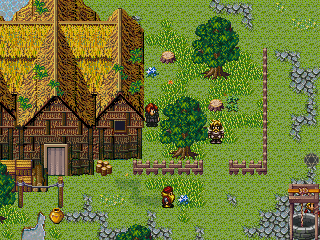
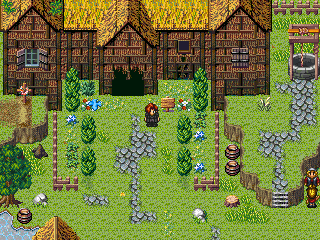
Through those pictures, one can easily see what I mean. The fences, potters, plants, trees, paths, wells, and all other things mark a clear property for each house. Though a house only takes up so much room, the fences and other things take up a much larger space, thus eliminating that space of nothingness between houses.
The second most important thing in Open Plains towns is generics. NONE of the houses should look the same. It’s ok to have a house or two that are the same if the chipset isn’t very good, but other then that, I would have to say that all houses should look different. It’s not that hard to make a good house, and it doesn’t take that much effort to copy it, and change it a bit.
However, that last rule can be swayed with proper spacing. Example:
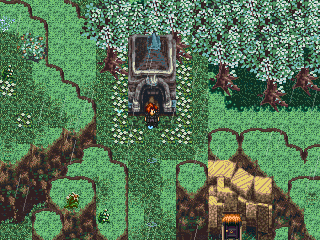
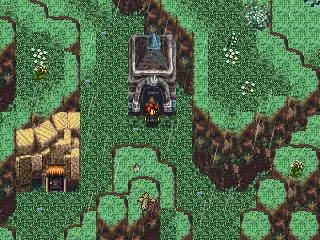
You can see that those two houses are exactly the same, but, because of what’s surrounding them, they both look good. One has trees and a garden around it; the other has saturated grasses and more high cliffs. As long as you vary your mapping a little between houses that look alike, then it shouldn’t be to bad.
Paths for towns. Open Plains towns always need a path. This can most often be done with dirt or rubble for the best effect. In the pictures above, again, the path is the darker grasses. Just like in the forest, people will follow this path in their mind without even knowing it.
In closed Areas: This can be many things. I’m saying here, that it’s a place without a limitless amount of land, such as a cave, mountain town, floating island, etc etc. These maps should have the same things In them as an Open Plains town, space and property. However, because it’s supposed to be a limited area, the houses and property should be loads smaller. It’s important to include paths in this as well, but the most important thing is to include areas you can’t walk at. A secluded area always has more then one strip of land to walk, but they aren’t always connected. Example:
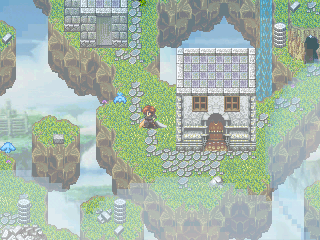
Though you can’t walk to that part in the lower corner of the floating island town, you can see it. Also, as you can see, this place has a basic path going from house to house. This is a good example of what a path should be like. The path doesn’t always have to be connected, but it’s a good idea to have one. In fact, I think it looks better the way it is in that last picture then a full path. It still gives the effects of a path, but doesn’t look like something you’re actually ‘supposed’ to walk along, if you get what I mean.
In Closed Towns are the easiest towns to make beautiful. Your peasants, (whatever residents you have) don’t need real detailed dwellings like the big fancy houses in the Open Plains maps. Places like a cave for example, wouldn’t have houses as it is. They would have small caves that people would sleep in, and that’s mostly it. Thus meaning, your main detail should go on the outside on limiting space but still making it seem like you can walk a wide array of paths. Example (yes, I know I did a waterfall boo-boo)
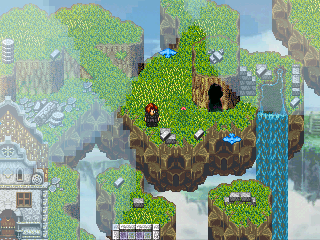
As you can see, right here hero can chose to go up to the temple, go right and go up the slope to the house in the corner, go right and go down to the basement of that same house, or go left into the little dwelling.
Note: the Panorama here is kind of broken because it was assembled than exported as a whole

Rules for every town:
Don’t crowd, as crowding will make it difficult to put in events, solely because the people will move into your way, and you will have to stop moving for awhile and wait for the people to get out of your way.
Don’t put a lot of people in the town. Basically, don’t put some 20 people walking outside in the town grounds. Unless you’ve got the space, or each event is really important, try to limit it. I find that putting 1-3 people per LARGE house you’ve got walking outside, and 1 person for every 2 SMALL housings you have work pretty well in most cases.
Eventing is a must in all cases. Animals should be on or near the top of that. If you look, almost all of my in-town pictures have a bird or butterfly in them. These animals add a peaceful effect on the town. If you’re going for an evil town, then you should still have animals, but make them things like ravens, crows, and dead/near-dead beasts. Picture effects are good as well. Clouds and cherry blossoms are two of my favorite ones to use, but rain and other weather effects work just as well.
Avoid repeating yourself as much as possible. In real life, most times no two houses look the same, even in poverty stricken places. Make everything different.
Put in things like wells and docks as often as you can. Putting in those not only decorates the place a bit, but also lines you put to put in events about a guy saying he dropped his ring down the well, or a boy saying he can skip the stone the farthest. Easy events.
Have loads of objects between your property lines. Anything will do, a tree, a broken down cart, a rock, anything. No one wants to look at an empty space.
That’s it for towns.
Table of contents:
1 The basics
a the 'yeses'
b the 'noes'
2 The specific Basics:
a Mountains
b Forests
c Towns (you are here)
d Deserts
e Plains
f World Map Tips
3 Adding to a map
a Eventing
b Overlapping
c Effects
d Overlays
*****************************************************************************
Towns are one of the most important parts in a game solely because of the huge amount of time you spend in them. If you’re game is something like mine, were you get to a town and stay in that central area for hours doing quests, it’s important to have a good looking town that has many things to do in it. There are three types of towns in my opinion. They are:
Castles
Open Plains
In closed areas (such as towns in a cave, on a mountain, etc.)
Castles: Castle towns are important to many games, but an important thing is to have residences. All castles have rooms for there knights to live in, but for some reason people tend to forget about that. However, I’m talking more about the exterior of a town, not the insides. Castle towns should have houses on the outside, in a courtyard fashion. Example:


As you can see, the place still has an outdoor castle feel, but it’s also got all the things a town would have, such as houses and people and bird and… on and on. You also don’t need a lot of space between places like you do in other maps, and as I go into property, you’ll figure out your own ways of doing that yourself (canvas tents, welcome mats, etc.)
Open Plains: These are by far the most common of all, and appear at least 5 times in most games. That is why it’s important to make them stand out. Space is the most important thing in any town, and it’s especially important here. You need a lot of space between each house, but you don’t want it to look like there’s a lot of unclaimed land. That’s what thing I call “property markers” are for. These markers aren’t houses, but they show property and ownership of a house still the same. Examples:


Through those pictures, one can easily see what I mean. The fences, potters, plants, trees, paths, wells, and all other things mark a clear property for each house. Though a house only takes up so much room, the fences and other things take up a much larger space, thus eliminating that space of nothingness between houses.
The second most important thing in Open Plains towns is generics. NONE of the houses should look the same. It’s ok to have a house or two that are the same if the chipset isn’t very good, but other then that, I would have to say that all houses should look different. It’s not that hard to make a good house, and it doesn’t take that much effort to copy it, and change it a bit.
However, that last rule can be swayed with proper spacing. Example:


You can see that those two houses are exactly the same, but, because of what’s surrounding them, they both look good. One has trees and a garden around it; the other has saturated grasses and more high cliffs. As long as you vary your mapping a little between houses that look alike, then it shouldn’t be to bad.
Paths for towns. Open Plains towns always need a path. This can most often be done with dirt or rubble for the best effect. In the pictures above, again, the path is the darker grasses. Just like in the forest, people will follow this path in their mind without even knowing it.
In closed Areas: This can be many things. I’m saying here, that it’s a place without a limitless amount of land, such as a cave, mountain town, floating island, etc etc. These maps should have the same things In them as an Open Plains town, space and property. However, because it’s supposed to be a limited area, the houses and property should be loads smaller. It’s important to include paths in this as well, but the most important thing is to include areas you can’t walk at. A secluded area always has more then one strip of land to walk, but they aren’t always connected. Example:

Though you can’t walk to that part in the lower corner of the floating island town, you can see it. Also, as you can see, this place has a basic path going from house to house. This is a good example of what a path should be like. The path doesn’t always have to be connected, but it’s a good idea to have one. In fact, I think it looks better the way it is in that last picture then a full path. It still gives the effects of a path, but doesn’t look like something you’re actually ‘supposed’ to walk along, if you get what I mean.
In Closed Towns are the easiest towns to make beautiful. Your peasants, (whatever residents you have) don’t need real detailed dwellings like the big fancy houses in the Open Plains maps. Places like a cave for example, wouldn’t have houses as it is. They would have small caves that people would sleep in, and that’s mostly it. Thus meaning, your main detail should go on the outside on limiting space but still making it seem like you can walk a wide array of paths. Example (yes, I know I did a waterfall boo-boo)

As you can see, right here hero can chose to go up to the temple, go right and go up the slope to the house in the corner, go right and go down to the basement of that same house, or go left into the little dwelling.
Note: the Panorama here is kind of broken because it was assembled than exported as a whole

Rules for every town:
Don’t crowd, as crowding will make it difficult to put in events, solely because the people will move into your way, and you will have to stop moving for awhile and wait for the people to get out of your way.
Don’t put a lot of people in the town. Basically, don’t put some 20 people walking outside in the town grounds. Unless you’ve got the space, or each event is really important, try to limit it. I find that putting 1-3 people per LARGE house you’ve got walking outside, and 1 person for every 2 SMALL housings you have work pretty well in most cases.
Eventing is a must in all cases. Animals should be on or near the top of that. If you look, almost all of my in-town pictures have a bird or butterfly in them. These animals add a peaceful effect on the town. If you’re going for an evil town, then you should still have animals, but make them things like ravens, crows, and dead/near-dead beasts. Picture effects are good as well. Clouds and cherry blossoms are two of my favorite ones to use, but rain and other weather effects work just as well.
Avoid repeating yourself as much as possible. In real life, most times no two houses look the same, even in poverty stricken places. Make everything different.
Put in things like wells and docks as often as you can. Putting in those not only decorates the place a bit, but also lines you put to put in events about a guy saying he dropped his ring down the well, or a boy saying he can skip the stone the farthest. Easy events.
Have loads of objects between your property lines. Anything will do, a tree, a broken down cart, a rock, anything. No one wants to look at an empty space.
That’s it for towns.
Posts 

Pages:
1
Pages:
1













